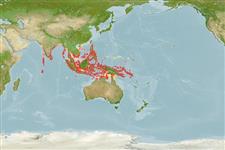Environment: milieu / climate zone / depth range / distribution range
Ecología
marino asociado a arrecife; rango de profundidad 3 - 36 m (Ref. 9710). Tropical; 23°N - 14°S, 71°E - 165°E (Ref. 55)
Indo-Pacific: mainly the Indo-Australian Archipelago from the Solomon Islands to Sumatra, and from off Cape York Peninsula, Australia, northward to the Philippines; also occurring in the central and eastern Indian Ocean as far west as Maldives.
Tamaño / Peso / Age
Maturity: Lm ? range ? - ? cm
Max length : 25.0 cm TL macho / no sexado; (Ref. 48635); common length : 15.0 cm TL macho / no sexado; (Ref. 55)
Espinas dorsales (total): 11; Radios blandos dorsales (total): 12; Espinas anales 3; Radios blandos anales: 8. Snout profile low, sloping very gently. Preorbital bone narrow, its width less than half of eye diameter. Preopercular notch and knob poorly developed. Scale rows on back rising obliquely above lateral line. Generally dark brown of the upper part of the head and body with a broad white horizontal band immediately below. The lower part of the head and body dusky brown with a suffusion of yellow. A pair of white spots is on the back just below the dorsal fin base (Ref. 469).
Adults inhabit coral reefs (Ref. 9710, 48635) and outer reef slopes (Ref. 37816, 48635). They sometimes form large schools of more than 100 individuals. Often solitary (Ref. 48635). Feed mainly on small fishes and crustaceans. Generally uncommon (Ref. 9710).
Life cycle and mating behavior
Madurez | Reproducción | Puesta | Huevos | Fecundidad | Larva
Allen, G.R., 1985. FAO Species Catalogue. Vol. 6. Snappers of the world. An annotated and illustrated catalogue of lutjanid species known to date. FAO Fish. Synop. 125(6):208 p. Rome: FAO. (Ref. 55)
IUCN Red List Status (Ref. 130435)
Threat to humans
Harmless
Human uses
Pesquerías: comercial
Más información
Nombres comunesSinónimosMetabolismoDespredadoresEcotoxicologíaReproducciónMadurezPuestaAgregación para la puestaFecundidadHuevosEgg development
ReferenciasAcuiculturaPerfil de acuiculturaRazasGenéticaElectrophoresesheritabilidadEnfermedadesProcesamientoNutrientsMass conversion
ColaboradoresImágenesStamps, Coins Misc.SonidosCiguateraVelocidadTipo de nataciónSuperficie branquialOtolitosCerebrosVisión
Herramientas
Special reports
Download XML
Fuentes de Internet
Estimates based on models
Preferred temperature (Ref.
123201): 27.5 - 29.2, mean 28.6 °C (based on 602 cells).
Phylogenetic diversity index (Ref.
82804): PD
50 = 0.5000 [Uniqueness, from 0.5 = low to 2.0 = high].
Bayesian length-weight: a=0.01479 (0.00706 - 0.03101), b=2.97 (2.81 - 3.13), in cm total length, based on LWR estimates for this Genus-body shape (Ref.
93245).
Nivel trófico (Ref.
69278): 4.0 ±0.65 se; based on food items.
Resiliencia (Ref.
120179): Alto, población duplicada en un tiempo mínimo inferior a 15 meses (Preliminary K or Fecundity.).
Fishing Vulnerability (Ref.
59153): Low vulnerability (15 of 100).
Nutrients (Ref.
124155): Calcium = 56 [34, 91] mg/100g; Iron = 0.447 [0.286, 0.738] mg/100g; Protein = 18.3 [16.8, 19.7] %; Omega3 = 0.139 [0.091, 0.218] g/100g; Selenium = 46.4 [26.6, 79.4] μg/100g; VitaminA = 283 [54, 1,152] μg/100g; Zinc = 0.498 [0.369, 0.726] mg/100g (wet weight);
